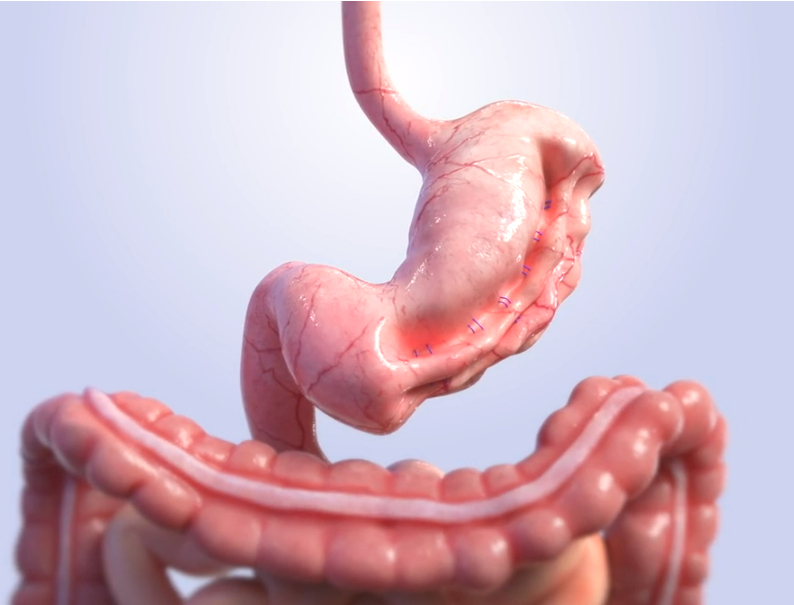DUO PROCEDURE

Are you struggling to lose weight despite trying various diets and exercise routines?
If you're significantly overweight and haven't been eligible for other bariatric surgeries, our Duo Procedure, also known as Endoscopic Sleeve Gastroplasty, may be the ideal option for you.
How Does the Duo Procedure Work?
The Duo Procedure is a non-surgical, minimally invasive approach that involves suturing the stomach from the inside to reduce its size, much like a traditional gastric sleeve surgery. This results in a smaller stomach, making you feel fuller quicker and aiding in weight loss. Additionally, certain parts of the stomach are bypassed, leading to reduced calorie absorption by the body.
Endoscopic sleeve gastroplasty is for anyone who is significantly overweight and has tried diet and exercise without results. This procedure is an option for people who are not candidates for other bariatric surgeries, the endoscopic sleeve uses sutures to minimize the size of the stomach.
This non-surgical, minimally invasive procedure limits the amount of food a patient can eat, which increases fullness to help eliminate excess weight. Endoscopic sleeve gastroplasty, as with all other weight loss procedures we offer, patients must commit to a healthy lifestyle to best ensure long-term success.
How does the endoscopic sleeve work?
This procedure is performed from inside the body using a camera and an endoscopic suture device that is placed into the stomach through the throat. The suture will contract the stomach to a size similar to gastric sleeve surgery, about the size of a banana, approximately 50 to 150 milliliters. Because the stomach is smaller, the patient will feel fuller faster. Also, because certain parts of the stomach are no longer exposed to food, the body cannot absorb as many calories as before.
Compared to gastric sleeve surgery, the endoscopic sleeve procedure is non-invasive. It can also be reversed and repeated to suit the patient's needs. Studies have shown that patients can lose 30-60% of body fat up to six months after the endoscopic sleeve procedure with proper exercise and diet.
Do I qualify for the endoscopic sleeve?
If you answer "yes" to all of the questions below, you may qualify!
- Do you have a BMI between 30 and 35?
- Have you tried to lose weight with non-surgical methods without success?
- You do not have gastrointestinal bleeding or a hiatal hernia greater than 3 centimeters?
- Have you never had stomach surgery?
- Do you understand the risks, side effects and complications?
- Do you agree to make the necessary lifestyle changes?
- Can you commit to a healthy and active lifestyle?
Advantages of the endoscopic sleeve:
For patients who do not qualify for other bariatric surgeries, due to their body mass index, various health problems or abdominal scarring, the endoscopic sleeve is an effective option. The endoscopic sleeve can significantly reduce your risk of weight-related health problems, such as gastroesophageal reflux disease, heart disease, stroke, high blood pressure, sleep apnea and type 2 diabetes.
The endoscopic sleeve also reduces hunger, does not bypass the intestines, facilitates safe weight loss, allows digestion to occur naturally and does not require implantation of a medical device.
Disadvantages of the endoscopic sleeve
After the procedure, pain and nausea may persist for a few days. This pain and nausea can be effectively controlled with medications prescribed by your physician.
If a patient's diet becomes unbalanced and they continue to eat more than the portions recommended by their physician, their weight loss success will be hindered.
In addition, as with any medical procedure, there are corresponding potential risks that your physician will inform you of in detail.
Before the procedure
Follow the pre-procedure diet prescribed by your doctor. Also, avoid drinking or eating anything after midnight on the day of your surgery. If you drink or eat anything during this time, your procedure will be cancelled. Check with your doctor to see if you can take your daily medications on the day of your surgery.
You may need lab tests before surgery to better determine if the endoscopic procedure is right for you and your body.
Day of the procedure
At the hospital, you will be given general anesthesia before your procedure. Your doctor will insert an endoscope, a camera attached to a flexible tube, which is connected to an endoscopic suturing device into your stomach through your throat. This device allows your doctor to see inside your stomach and accurately make the appropriate abdominal incisions.
Your doctor will then place about 12 sutures in your stomach, decreasing the size of your stomach, which will restrict the calories your body can absorb. This will take about 90 minutes. You will then be taken to a recovery room for medical monitoring.
Most patients return home the same day they recover from sedation.
Day of the procedure
At the hospital, you will be given general anesthesia before your procedure. Your doctor will insert an endoscope, a camera attached to a flexible tube, which is connected to an endoscopic suturing device into your stomach through your throat. This device allows your doctor to see inside your stomach and accurately make the appropriate abdominal incisions.
Your doctor will then place about 12 sutures in your stomach, decreasing the size of your stomach, which will restrict the calories your body can absorb. This will take about 90 minutes. You will then be taken to a recovery room for medical monitoring.
Most patients return home the same day they recover from sedation.









